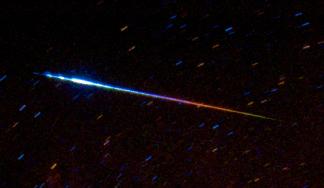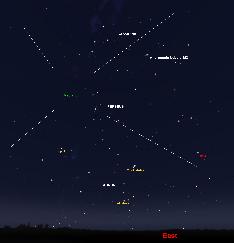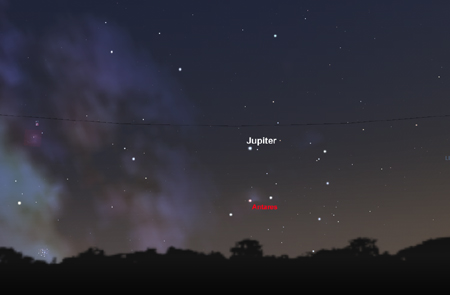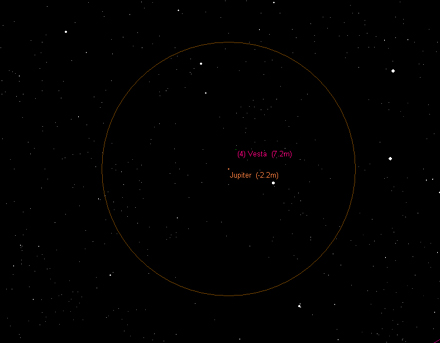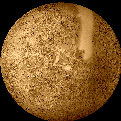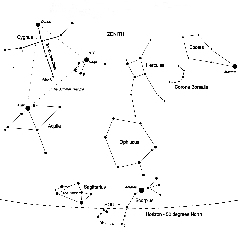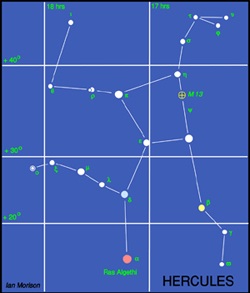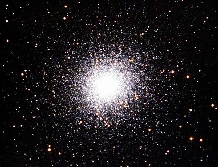The Night Sky August 2007
Compiled by Ian Morison
This page, updated monthly, will let you know some of the things that you can look out for in the night sky. It lists the phases of the Moon, where you will see the naked-eye planets and describes some of the prominent constellations in the night sky during the month.
Image of the Month
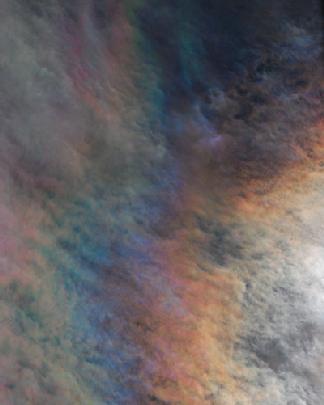
Iridescent Clouds - click for full sized image
Image:Ian Morison
This is an image taken by the compiler of this page at Lake Bled, Slovenia in early July of what are known as Iridescent Clouds. Whether it deserves to be an image of the month is another matter, but occasionally images of such clouds have appeared on the "Astronomy Picture of the Day" NASA site - and the phenomena is regarded a being rare. They are caused by the diffraction of light in very small uniform droplets rather than the refraction of light that, for example, results in rainbows. They are sometimes called Mother of Pearl clouds. The diffraction causes different colours to be diffracted by differing amounts so we see changing colours in different directions. They are only normally seen very close to the sun - in this image the Sun was just 15 degrees to the right - which is perhaps why we rarely notice them as we cannot look close to the Sun without being blinded by its light. In this case, the Sun was just hidden by an overhanging balcony.
More Iridescent Cloud Images from Lake Bled: Iridescent Clouds
The Moon

The passage of the Moon through the Earth's shadow March 2007: Cape Newwise 200 mm telescope and Nikon D80 camera.
Ian Morison, Jodrell Bank Observatory
| new | first quarter | full moon | last quarter |
|---|---|---|---|
| August 12th | August 20nd | August 28th | August 05th |
Some Lunar Images by Ian Morison, Jodrell Bank Observatory: Lunar Images
Highlights of the Month
August 11th to 13th: View the Perseid Meteor Shower
If it is clear on the 11th and 12th of August, one will have an excellent chance of seeing the meteors in the Perseid Meteor Shower - the year's most dependable meteor shower. The great news this year is that the shower corresponds to New Moon so there will be no moonlight to hide the fainter members of the shower! Let's just hope that by then the clouds that covered the UK for almost the whole of July will have gone. Look up towards the North-East from 10 pm onwards on the nights of August 11th, 12th and 13th. After midnight, as Perseus rises higher into the sky, the numbers seen may well rise too! Most meteors are seen when looking about 50 degrees away from the "radiant" (the point from which the meteors appear to radiate from) which lies between Perseus and Cassiopea. (See the star chart below) The Perseid meteors are particles, usually smaller than a grain of sand, released as the comet Swift-Tuttle passes the Sun. The shower in quite long lived, so it is worth looking out any night from the 10th to the 15th of August. Good hunting!
August: Jupiter south in the evening.
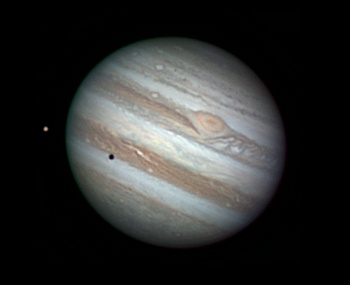
Jupiter - showing the Red Spot and the shadow of one of its Moons.
Image by Damian Peache using a 9.25 Celestron Schmidt Cassegrain Telescope.
To see more of Damian Peache's Images: Damian Peache's website
During August, Jupiter will be seen in the south (and highest in the sky) as the Sun sets. It shines with a magnitude of -2.5 up above the red star Antares in Scorpius. Though its disk id=s now reducing in size, from 42 down to 38.4 arc seconds during the month, there is still much detail to be seen. However Jupiter lies in the constellation Ophiuchus, part of which dips down between Scorpius and Sagittarius. Sadly, this is almost at the most southerly point of the ecliptic (the path of the Sun, and near to which the planets are found) so Jupiter will not be high in the sky for observers at our northern latitudes - about 16 degrees elevation from central England, but only ~11 degrees from northern Scotland. This means that it will be seen through quite a substantial atmosphere and so our views will not be as good as when Jupiter is higher in the sky. There is a second problem in that the atmosphere acts somewhat like a prism with the blue image of Jupiter appearing about 4 arc seconds above the red image. This will both add "false colour" to the image and blur it as well. One should thus use colour filters to observe it at a particular part of the spectrum. Different colours can help bring out different aspects of the surface. Light blue will darken the red spot and make the equatorial bands more prominent, whilst a light yellow filter can help bring out detail in the polar regions. The refractive aspects of the atmosphere will make it difficult to photograph Jupiter with a Toucam or other colour webcam. The best results will come if red, green and blue images are obtained separately using colour filters. Even better results will be obtained with narrow band filters such as OIII for Green and H-Alpha for the red.
A small telescope (or even binoculars resting on a wall to steady them) will allow you to observe the 4 bright Galilean Moons, Io, Europa, Ganymede and Callisto, discovered by Galilo Galilei in 1610. Sometimes the Moons cast a shadow on the surface which can be seen as a black dot in moderate sized telescopes. A telescope will enable you to easily see the equatorial belts - clouds at differing altitudes - and you may also spot the great red spot, though it is not quite so prominent now as it can sometimes be.
August 24-31: Observe the minor planet Vesta close to Jupiter.
Last month I suggested that you might like to try to observe the dwarf planet Ceres. If you live in the UK I doubt that you would have seen the night sky at all! But in the latter part of this month it is very easy to find the second most massive - but the brighest - member of the asteroid belt, Vesta. It is about 530 km across and contains ~ 9% of all the mass in the asteroid belt but it it has a more reflective surface than Ceres so, at magnitude 7.2, is considerably brighter than Ceres. This means that at high locations and dark skies it may even be seen with the unaided eye! Here though, in the UK, binoculars will be needed.
First find Jupiter - see the above highlight. Just to the lower right of Jupiter, just 44 arc minutes away, lies the 4th magnitude star Omega Ophiuchus. On the 24th, Vesta is up and to the right of this star a little further away than Jupiter
On the 25th, Vesta is above and just to the right at the same distance as Jupiter.
On the 26th, Vesta is above and to the left of this star and at 2 O'clock from Jupiter.
On the 27th, Vesta is at 1 O'clock from Jupiter, just 32 arc minutes away.
On the 28th, Vesta is above and just to the right of Jupiter, just 25 arc minutes away.
On the 29th, Vesta is above and just to the left of Jupiter, also 25 arc minutes away.
On the 30th, Vesta is above and at 10:30 O'clock to Jupiter at a distance of 32 arc minutes.
On the 31st, Vesta is above and at 10:00 to Jupiter at a distance of 43 arc minutes.
The point is, if you centre Jupiter in a pair of binoculars you
The Planets
Jupiter
Jupiter- see highlight above.
Saturn
Saturn On August 21st, Saturn lies directly behind the Sun, so remains out of sight all month.
Mercury
Mercury Mercury may just be visible in the pre-dawn sky at the very beginning of August, but passes behind the Sun on August 15th, so will remain out of sight for most of the month.
Note that the blank region in the image above is simply because this part of Mercury's surface has not yet been imaged in detail.
Mars
Mars, in Taurus, is now rising around midnight and rises to about 40 degrees elevation above the south-eastern horizon before dawn. Its disk is just 7.1 arc seconds across and it shines at magnitude +0.5 at the beginning of August. During the month its brightness increases to magnitude +0.4 and the disc increases to 8 arc seconds. We still need to wait a month or so before we see it well, but under good conditions the polar caps and Sytris Major (a prominent dark marking on the surface) should be visible. ( That is assuming that the current dust storm on Mars has subsided!) Mars is closest to the Sun in its elliptical orbit on August 19th, so is currently ~ 20% warmer than average - hence the dust storms - but the air temperature is still only -60 Celcius! Mars will reach opposition in December - a highlight of the winter months
Venus
Venus lie directly between the Earth and the Sun on the 18th August, but moves across the heavens very rapidly so that it might just be possible to spot it (at magnitide -4.5)low in the north-west just after sunset at the very beginning of the month and low in the north-east (at magnitude -4.4) just before dawn at the very end of the month. Its disc will be ~ 50 arc seconds across.
Find more planetary images and details about the Solar System: The Solar System
The Stars
The mid evening August Sky
Having virtually never seen the night sky in July, let's just hope that August will be better! Now that the evenings are drawing it the night sky gets darker earlier so encouraging one to go out to observe.
This map shows the constellations seen towards the south at about 10pm BST in mid August. High over head towards the north (not shown on the chart) lies Ursa Major. As one moves southwards one first crosses the constellation Hercules with its magnificent globular cluster, M13, and then across the large but not prominent constellation Ophiucus until, low above the souther horizon lie Sagittarius and Scorpio. To the right of Hercules lie the arc of stars making up Corona Borealis and then Bootes with its bright star Arcturus. Rising in the east is the beautiful region of the Milky Way containing both Cygnus and Lyra. Below is the constellation of Aquilla, the Eagle. The three bright stars Deneb (in Cygnus), Vega (in Lyra) and Altair (in Aquila) make up the "Summer Triangle".
The constellation Ursa Major
The stars of the Plough, shown linked by the thicker lines in the chart above, form one of the most recognised star patterns in the sky. Also called the Big Dipper, after the soup ladles used by farmer's wives in America to serve soup to the farm workers at lunchtime, it forms part of the Great Bear constellation - not quite so easy to make out! The stars Merak and Dubhe form the pointers which will lead you to the Pole Star, and hence find North. The stars Alcor and Mizar form a naked eye double which repays observation in a small telescope as Mizar is then shown to be an easily resolved double star. A fainter reddish star forms a triangle with Alcor and Mizar.
Ursa Major contains many interesting "deep sky" objects. The brightest, listed in Messier's Catalogue, are shown on the chart, but there are many fainter galaxies in the region too. In the upper right of the constellation are a pair of interacting galaxies M81 and M82 shown in the image below. M82 is undergoing a major burst of star formation and hence called a "starburst galaxy". They can be seen together using a low power eyepiece on a small telescope.
Another, and very beautiful, galaxy is M101 which looks rather like a pinwheel firework, hence its other name the Pinwheel Galaxy. It was discovered in1781 and was a late entry to Messier's calalogue of nebulous objects. It is a type Sc spiral galaxy seen face on which is at a distance of about 24 million light years. Type Sc galaxies have a relativly small nucleus and open spiral arms. With an overall diameter of 170,000 light it is one of the largest spirals known (the Milky Way has a diameter of ~ 130,000 light years).
Though just outside the constellation boundary, M51 lies close to Alkaid, the leftmost star of the Plough. Also called the Whirlpool Galaxy it is being deformed by the passage of the smaller galaxy on the left. This is now gravitationally captured by M51 and the two will eventually merge. M51 lies at a distance of about 37 million light years and was the first galaxy in which spiral arms were seen. It was discovered by Charles Messier in 1773 and the spiral structure was observed by Lord Rosse in 1845 using the 72" reflector at Birr Castle in Ireland - for many years the largest telescope in the world.
Lying close to Merak is the planetary nebula M97 which is usually called the Owl Nebula due to its resemblance to an owl's face with two large eyes. It was first called this by Lord Rosse who drew it in 1848 - as shown in the image below right. Planetary nebulae ar the remnants of stars similar in size to our Sun. When all possible nuclear fusion processes are complete, the central core collpses down into a "white dwarf" star and the the outer parts of the star are blown off to form the surrounding nebula.
The constellation Hercules
Between the constellation Bootes and the bright star Vega in Lyra lies the constellation Hercules.The Red Giant star Alpha Herculis or Ras Algethi, its arabic name, is one of the largest stars known, with a diameter of around 500 times that of our Sun. In common with most giant stars it varies its size, changing in brightness as it does so from 3rd to 4th magnitude. Lying along one side of the "keystone" lies one of the wonders of the skies, the great globular cluster, M13. Just visible to the unaided eye on a dark clear night, it is easily seen through binoculars as a small ball of cotten wool about 1/3 the diameter of the full Moon. The brightness increases towards the centre where the concentration of stars is greatest. It is a most beautiful sight in a small telescope. It contains around 300,000 stars in a region of space 100 light years across, and is the brightest globular cluster that can be seen in the northern hemisphere.
The constellation Virgo
Virgo, in the south-east after sunset this month, is not one of the most prominent constellations, containing only one bright star, Spica, but is one of the largest and is very rewarding for those with "rich field" telescopes capable of seeing the many galaxies that lie within its boundaries. Spica is, in fact, an exceedingly close double star with the two B type stars orbiting each other every 4 days. Their total luminosity is 2000 times that of our Sun. In the upper right hand quadrant of Virgo lies the centre of the Virgo Cluster of galaxies. There are 13 galaxies in the Messier catalogue in this region, all of which can be seen with a small telescope. The brightest is the giant elliptical galaxy, M87, with a jet extending from its centre where there is almost certainly a massive black hole into which dust and gas are falling. This releases great amounts of energy which powers particles to reach speeds close to the speed of light forming the jet we see. M87 is also called VIRGO A as it is a very strong radio source.
Below Porrima and to the right of Spica lies M104, an 8th magnitude spiral galaxy about 30 million light years away from us. Its spiral arms are edge on to us so in a small telescope it appears as an elliptical galaxy. It is also known as the Sombrero Galaxy as it looks like a wide brimmed hat in long exposure photographs.
The constellations Lyra and Cygnus
This month the constellations Lyra and Cygnus are rising in the East as darkness falls with their bright stars Vega, in Lyra, and Deneb, in Cygnus, making up the "summer triangle" of bright stars with Altair in the constellation Aquila below. (see sky chart above)
Lyra
Lyra is dominated by its brightest star Vega, the fifth brightest star in the sky. It is a blue-white star having a magnitude of 0.03, and lies 26 light years away. It weighs three times more than the Sun and is about 50 times brighter. It is thus burning up its nuclear fuel at a greater rate than the Sun and so will shine for a correspondingly shorter time. Vega is much younger than the Sun, perhaps only a few hundred million years old, and is surrounded by a cold,dark disc of dust in which an embryonic solar system is being formed!
There is a lovely double star called Epsilon Lyrae up and to the left of Vega. A pair of binoculars will show them up easily - you might even see them both with your unaided eye. In fact a telescope, provided the atmosphere is calm, shows that each of the two stars that you can see is a double star as well so it is called the double double!
Between Beta and Gamma Lyra lies a beautiful object called the Ring Nebula. It is the 57th object in the Messier Catalogue and so is also called M57. Such objects are called planetary nebulae as in a telescope they show a disc, rather like a planet. But in fact they are the remnants of stars, similar to our Sun, that have come to the end of their life and have blown off a shell of dust and gas around them. The Ring Nebula looks like a greenish smoke ring in a small telescope, but is not as impressive as it is shown in photographs in which you can also see the faint central "white dwarf" star which is the core of the original star which has collapsed down to about the size of the Earth. Still very hot this shines with a blue-white colour, but is cooling down and will eventually become dark and invisible - a "black dwarf"! Do click on the image below to see the large version - its wonderful!
M56 is an 8th magnitude Globular Cluster visible in binoculars roughly half way between Alberio (the head of the Swan) and Gamma Lyrae. It is 33,000 light years away and has a diameter of about 60 light years. It was first seen by Charles Messier in 1779 and became the 56th entry into his catalogue.
Cygnus
Cygnus, the Swan, is sometimes called the "Northern Cross" as it has a distinctive cross shape, but we normally think of it as a flying Swan. Deneb,the arabic word for "tail", is a 1.3 magnitude star which marks the tail of the swan. It is nearly 2000 light years away and appears so bright only because it gives out around 80,000 times as much light as our Sun. In fact if Deneb where as close as the brightest star in the northern sky, Sirius, it would appear as brilliant as the half moon and the sky would never be really dark when it was above the horizon!
The star, Albireo, which marks the head of the Swan is much fainter, but a beautiful sight in a small telescope. This shows that Albireo is made of two stars, amber and blue-green, which provide a wonderful colour contrast. With magnitudes 3.1 and 5.1 they are regarded as the most beautiful double star that can be seen in the sky.
Cygnus lies along the line of the Milky Way, the disk of our own Galaxy, and provides a wealth of stars and clusters to observe. Just to the left of the line joining Deneb and Sadr, the star at the centre of the outstretched wings, you may, under very clear dark skys, see a region which is darker than the surroundings. This is called the Cygnus Rift and is caused by the obscuration of light from distant stars by a lane of dust in our local spiral arm. the dust comes from elements such as carbon which have been built up in stars and ejected into space in explosions that give rise to objects such as the planetary nebula M57 described above.
Deneb,the arabic word for "tail", is a 1.3 magnitude star which marks the tail of the swan. It is nearly 2000 light years away and appears so bright only because it gives out around 80,000 times as much light as our Sun. In fact if Deneb where as close as the brightest star in the northern sky, Sirius, it would appear as brilliant as the half moon and the sky would never be really dark when it was above the horizon!
There is a beautiful region of nebulosity up and to the left of Deneb which is visible with binoculars in a very dark and clear sky. Photographs show an outline that looks like North America - hence its name the North America Nebula. Just to its right is a less bright region that looks like a Pelican, with a long beak and dark eye, so not surprisingly this is called the Pelican Nebula. The photograph below shows them well.
Brocchi's Cluster An easy object to spot with binoculars in Gygnus is "Brocchi's Cluster", often called "The Coathanger",although it appears upside down in the sky! Follow down the neck of the swan to the star Alberio, then sweep down and to its lower left. You should easily spot it against the dark dust lane behind.


